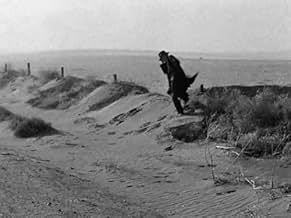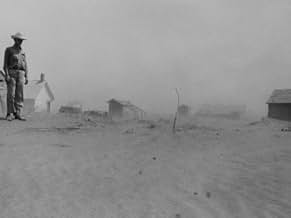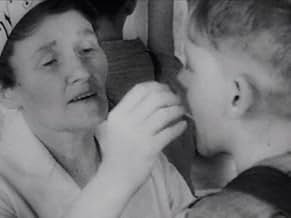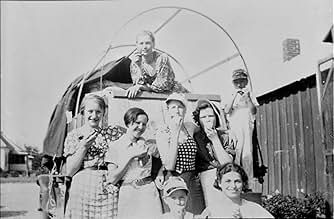PUNTUACIÓN EN IMDb
8,2/10
2,3 mil
TU PUNTUACIÓN
Documental sobre la sequía de las tierras agrícolas de las praderas norteamericanas en la década de 1930 y sus consecuencias durante la gran depresión.Documental sobre la sequía de las tierras agrícolas de las praderas norteamericanas en la década de 1930 y sus consecuencias durante la gran depresión.Documental sobre la sequía de las tierras agrícolas de las praderas norteamericanas en la década de 1930 y sus consecuencias durante la gran depresión.
- Nominado para 2 premios Primetime Emmy
- 2 premios y 5 nominaciones en total
Explorar episodios
Reseñas destacadas
This is a sometimes difficult-to-watch documentary about the 1930s in the western panhandle of Oklahoma and the area immediately around it, the center of what came to be called the Dust Bowl. Like Burns' other documentaries, at its center is a well-researched narrative that moves in chronological order, delivered wonderfully by his narrator, Peter Cayote, with the perfect voice for an American story.
But also like at least some of Burns' other documentaries, what makes this hit you in the gut, what makes a real impression on you, is seeing and hearing those who lived through this terrible era recall it while trying to keep their emotions in check. As one of them says late in the second part, some survived because they were strong, but others did not. You see that strength in these people. They are all in their 80s or 90s, I would guess, and some appear to be rather frail physically. But they are clearly very strong, yet very modest, individuals.
At one moment in the narrative, we are told about a photographer who was sent out by the federal government to capture the suffering of these people and their plight, so that other Americans would understand the need to help them. The photograph, a woman, was told to make sure to capture their faces and their eyes. That's what Burns does in shooting these witnesses almost 80 years later, and the power of the result is amazing.
That, of course, is the appeal of at least some of Burns' documentaries. They tell us things about America and Americans that we would like to believe are true about ourselves, at least when we are at our very best.
Did all of these witnesses lead perfect lives, with never an unkind word or thought ? Maybe, maybe not. I don't know, and I don't care. But they give us something to strive for, because they tell us that, at least in some of us, at some times, there is a remarkable resilience.
But also like at least some of Burns' other documentaries, what makes this hit you in the gut, what makes a real impression on you, is seeing and hearing those who lived through this terrible era recall it while trying to keep their emotions in check. As one of them says late in the second part, some survived because they were strong, but others did not. You see that strength in these people. They are all in their 80s or 90s, I would guess, and some appear to be rather frail physically. But they are clearly very strong, yet very modest, individuals.
At one moment in the narrative, we are told about a photographer who was sent out by the federal government to capture the suffering of these people and their plight, so that other Americans would understand the need to help them. The photograph, a woman, was told to make sure to capture their faces and their eyes. That's what Burns does in shooting these witnesses almost 80 years later, and the power of the result is amazing.
That, of course, is the appeal of at least some of Burns' documentaries. They tell us things about America and Americans that we would like to believe are true about ourselves, at least when we are at our very best.
Did all of these witnesses lead perfect lives, with never an unkind word or thought ? Maybe, maybe not. I don't know, and I don't care. But they give us something to strive for, because they tell us that, at least in some of us, at some times, there is a remarkable resilience.
Amazing information...and the interviews you assembled were fantastic. I had heard of this but was completely ignorant as to just how significant it was.
The stories told by the interviewees were both extremely sad and inspiring. I can't believe that families never left. The one fact that still sticks out is that during one dust storm, an extremely bad one, dirt from the Midwest ended up out on the deck of a ship in the Atlantic and in the White House amazing
And thank God you interviewed those people when you did. We need to be taking advantage of our elders and their experiences the way this documentary did.
The stories told by the interviewees were both extremely sad and inspiring. I can't believe that families never left. The one fact that still sticks out is that during one dust storm, an extremely bad one, dirt from the Midwest ended up out on the deck of a ship in the Atlantic and in the White House amazing
And thank God you interviewed those people when you did. We need to be taking advantage of our elders and their experiences the way this documentary did.
10kironkid
I've only viewed part 1 (last night) and I'm anxiously awaiting part 2, which is tonight. So far, it has been very good and informative. A significant piece of American history. One we should all be knowledgeable on. We had a large part in creating this natural catastrophe, and we are doomed to do similar things if we continue to do as we are presently doing. It reminds me of the recent flooding in New York, New Jersey and Japan. Much of that damage and loss can be contributed to poor planning on mankind. Nature is cyclical. We just choose to ignore the past history.
Very good and informative. I highly recommend it.
Russ
Very good and informative. I highly recommend it.
Russ
This is a decent documentary and if you don't know much about the dust bowl then it will give you a good overview. I was a bit disappointed to find that part 1 was very similar to a television documentary called: 'The American Experience - Surviving the Dust Bowl' and featured much of the same footage and photographs and talking heads. I guess this mini series is four times longer overall so it's a better option if you want a more in depth look at this very sad time in recent north American history. I have to say that I find the music in the background is a bit distracting and often had to rewind bits that I didn't catch because my mind had wandered with the music.
This "docu-drama" contained more political statements than a French feminist melodrama. OK, I admit I exaggerate but if you want to make a documentary you have to consider all possible angles and not be a servant to your own point of view. This is not a documentary. It is Ken Burns world view about the dust bowl. Don't look for reasonable explanations about the causes and circumstances in which the event occurred. It like one of those zombie movies, you know the ones which starts like, "its the year 2137, there has been a deadly virus attack and only few humans survive and the rest have turned to zombies". You know this is not a real story yet they put enough real circumstances in it for you to be engaged. This is the zombie movie of documentaries.
¿Sabías que...?
- CuriosidadesExtracts from the interviews in this documentary were used by Christopher Nolan in Interstellar (2014) when depicting the dust storms on Earth.
- ConexionesFeatured in Interstellar (2014)
- Banda sonoraThe Plainsman
Written by John Owen Lardinois
Performed by Fiddlin' Johnny
From Cowboy Legacy
© 1997 Makoché Music
Selecciones populares
Inicia sesión para calificar y añadir a tu lista para recibir recomendaciones personalizadas
- How many seasons does The Dust Bowl have?Con tecnología de Alexa
Detalles
- Fecha de lanzamiento
- País de origen
- Sitio oficial
- Idioma
- Títulos en diferentes países
- Dust Bowl - Die Jahrhundertdürre
- Empresas productoras
- Ver más compañías en los créditos en IMDbPro
- Duración46 minutos
- Color
Contribuir a esta página
Sugerir un cambio o añadir el contenido que falta

Principal laguna de datos
By what name was The Dust Bowl (2012) officially released in India in English?
Responde








